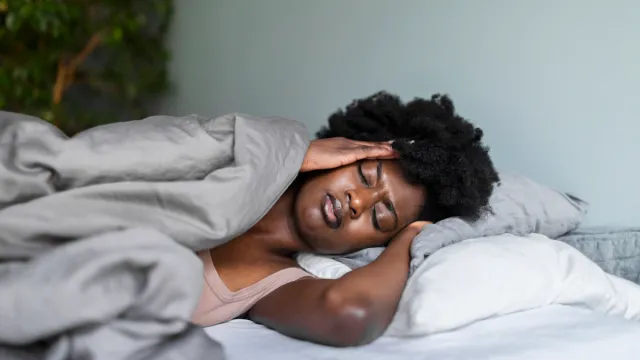Dream Expert Reveals How Your Sleep Position Could Be Giving You Nightmares

The average person will spend one-third of their life sleeping. That’s a lot of zzz’s—not to mention, a lot of dreaming. And as many of us know, nothing ruins a good night’s sleep more than a torrid nightmare.
Our quality of sleep is affected by a myriad of factors, some of which can also impact our REM sleep, aka our dream cycle. For example, you may have heard that people are more likely to experience nightmares after consuming alcohol. Anxiety and stress are also associated with a greater risk of scary dreams. However, did you know that your sleep position could be the culprit behind your nightmares, too?
RELATED: 60 Common Dreams and Their Secret Meanings, According to Experts.
In a 2004 study published in the journal Sleep and Hypnosis, 41 right-side sleepers and 22 left-side sleepers were asked a series of questions about “dream recall frequency,” “nightmare frequency,” and “dream emotions.”
Despite the study including nearly twice as many right-side sleepers, the rate of nightmare frequency was significantly higher amongst left-side sleepers. Forty percent of left-side sleepers said they have nightmares, compared to 14 percent of right-siders. So, why is that?
In response to the study, dream decoder and best-selling author Theresa Cheung, told Tom’s Guide that sleeping on your left side “can be associated with nightmares because left-side sleeping puts more stress on the heart. Whenever there is stress, sleep quality is poor and nightmares are sure to follow.”
Experts warn—and research shows—that back sleepers aren’t any better off than left-side sleepers. “There is more research to suggest that sleeping on your back triggers nightmares,” Cheung said.
The correlation between sleeping on your back and nightmares comes down to your quality—or rather, lack of—breathing. “The work of breathing is harder when you’re on your back. Your tongue slides backwards and your breathing is more labored,” Rafael Pelayo, MD, a professor of psychiatry and behavioral sciences at the Stanford Center For Sleep Sciences and Medicine, told PopSugar.
When you sleep on your back, it becomes easier for your brain to slip out of REM sleep because it turns its attention to your body’s lack of airflow, thus causing your body to stir, awaken, and open your throat for air. During all of this, “You become aware of whatever the content of your dreams are,” Pelayo said.
There is also research to suggest that sleeping on your stomach can trigger nightmares. In 2012, researchers from Hong Shue Yan University in Hong Kong studied 670 adult participants and found that sleeping in this position triggered dreams of “sexual, erotomaniac, and persecutory material, such as themes involving ‘having a sexual relationship with a big wheel or celebrity,’ ‘being smothered, unable to breathe,’ ‘being locked up,’ and ‘being tied, unable to move,'” according to the study published in the journal Dreams.
If you want to improve your quality of sleep, try sleeping on your right side for a nightmare-free slumber. However, do note that sleeping on your right side can exacerbate heartburn.
RELATED: For more up-to-date information, sign up for our daily newsletter.
- Source: Mayo Clinic: Nightmare disorder
- Source: Sleep and Hypnosis
- Source: Dreams